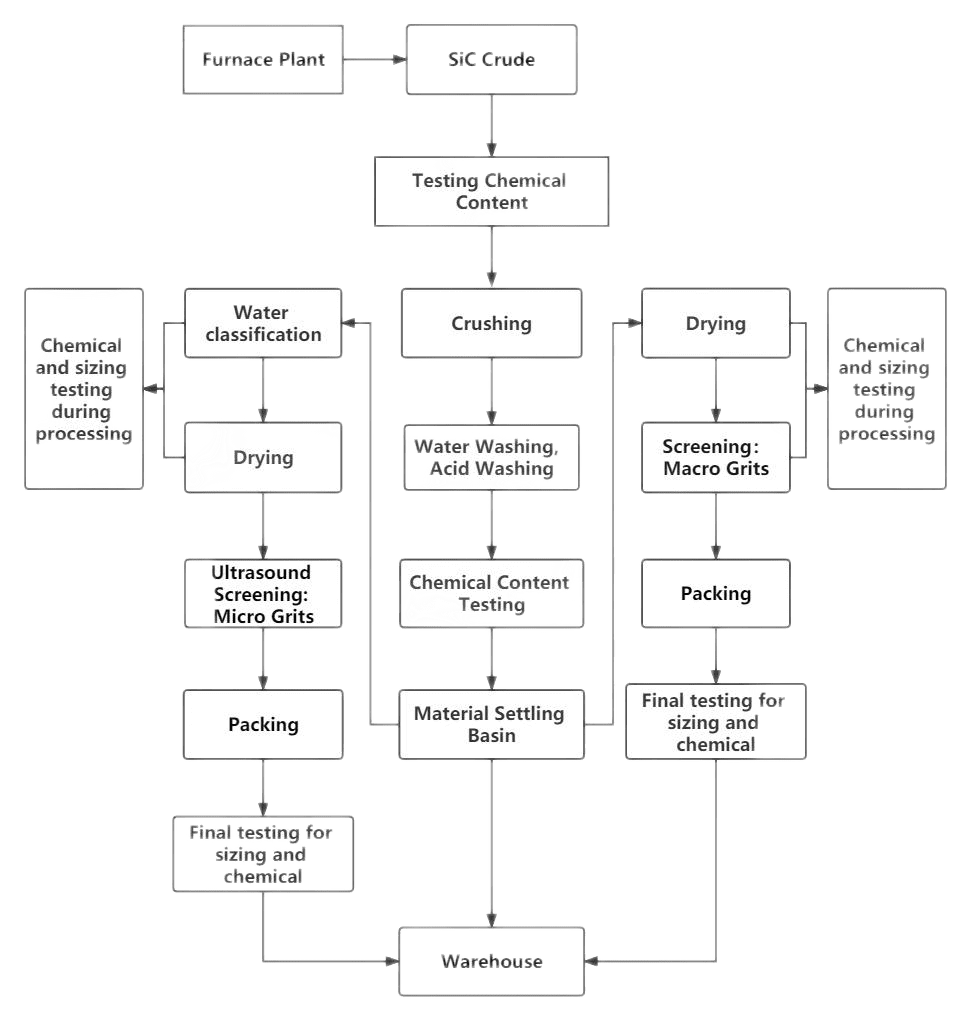Quy trình sản xuất cacbua silic
Quá trình sản xuất của cacbua silic bao gồm một số bước, đảm bảo sản xuất vật liệu chất lượng cao và đáng tin cậy.
nguyên liệu
Nguyên liệu chính được sử dụng trong sản xuất cacbua silic là silic và cacbon. Những nguyên liệu này được lựa chọn cẩn thận và trải qua quá trình thanh lọc nghiêm ngặt để loại bỏ tạp chất và đạt được thành phần mong muốn.
Chuẩn bị bột
Sau khi nguyên liệu đã được làm sạch, chúng được chuyển thành bột mịn thông qua các kỹ thuật khác nhau. Bột silic và cacbon được trộn theo tỷ lệ chính xác để đạt được thành phần cacbua silic mong muốn. Bột sau đó được nghiền và nghiền để có được sự phân bố kích thước hạt đồng đều, đảm bảo tính nhất quán trong sản phẩm cuối cùng.
Trộn và tạo hình
Trong giai đoạn này, bột cacbua silic được trộn với chất kết dính và chất phụ gia để nâng cao khả năng làm việc và khả năng tạo hình của chúng. Hỗn hợp này sau đó được định hình thành dạng mong muốn bằng các kỹ thuật khác nhau như ép, phun ra, hoặc đúc trượt. Bước này cho phép Nhà sản xuất của để tạo ra nhiều loại sản phẩm, từ các thành phần gốm phức tạp đến các hạt mài mòn cho các ứng dụng mài.
thiêu kết
Thiêu kết là một quá trình quan trọng liên quan đến việc nung nóng cacbua silic đã định hình ở nhiệt độ cao, thường trong môi trường được kiểm soát hoặc trong điều kiện chân không. Trong quá trình thiêu kết, bột liên kết với nhau, dẫn đến một vật liệu dày đặc và rắn chắc với các tính chất cơ học được cải thiện. Nhiệt độ và thời gian thiêu kết được kiểm soát cẩn thận để đạt được mật độ mong muốn và tính toàn vẹn cấu trúc của sản phẩm cuối cùng.
Hoàn thiện và kiểm soát chất lượng
Sau khi thiêu kết, các sản phẩm cacbua silic trải qua các bước xử lý và hoàn thiện bổ sung để đáp ứng các yêu cầu cụ thể. Điều này có thể bao gồm mài, đánh bóng, hoặc lớp phủ để đạt được bề mặt mong muốn và độ chính xác kích thước. Các biện pháp kiểm soát chất lượng, chẳng hạn như kiểm tra, thử nghiệm, và phân tích, được thực hiện trong suốt quá trình sản xuất để đảm bảo rằng các sản phẩm cacbua silic đáp ứng các tiêu chuẩn và thông số kỹ thuật cần thiết.


Ứng dụng của cacbua silic
Cacbua silic tìm thấy ứng dụng trong nhiều ngành công nghiệp nhờ tính chất đặc biệt và tính linh hoạt của nó. Một số lĩnh vực ứng dụng chính bao gồm:
Chất mài mòn và mài
Độ cứng đặc biệt và khả năng chống mài mòn của cacbua silic khiến nó trở thành lựa chọn lý tưởng cho các vật liệu mài mòn. Nó được sử dụng trong sản xuất bánh mài, dụng cụ cắt, và giấy nhám, mang lại hiệu suất vượt trội và kéo dài tuổi thọ dụng cụ trong các nguyên công gia công và hoàn thiện bề mặt khác nhau.
Gốm sứ và Vật liệu chịu lửa
Độ bền cao của cacbua silic, khả năng chống sốc nhiệt tuyệt vời, và khả năng chống lại sự tấn công hóa học làm cho nó trở thành một vật liệu có giá trị trong sản xuất gốm sứ và sản phẩm chịu lửa. Nó được sử dụng trong đồ nội thất lò nung, nồi nấu kim loại, và các thành phần nhiệt độ cao, cho phép hiệu suất đáng tin cậy trong môi trường nhiệt độ cao và ăn mòn.
Điện tử và chất bán dẫn
Cacbua silic đã thu hút được sự chú ý đáng kể trong lĩnh vực điện tử và chất bán dẫn. Tính chất điện độc đáo của nó, chẳng hạn như điện áp đánh thủng cao, độ dẫn nhiệt cao, và băng thông rộng, làm cho nó phù hợp với các thiết bị điện tử công suất, Đèn LED, và điện tử nhiệt độ cao.
Ô tô và Vận tải
Ngành công nghiệp ô tô đang ngày càng áp dụng cacbua silic cho các ứng dụng khác nhau. Nó được sử dụng trong sản xuất các bộ phận như đĩa phanh, ly hợp, và bộ phận động cơ, cung cấp hiệu suất vượt trội, giảm cân, và cải thiện hiệu quả sử dụng nhiên liệu. Điện tử điện dựa trên cacbua silic cũng đang cách mạng hóa hệ thống sạc xe điện, cho phép sạc nhanh hơn và tăng mật độ năng lượng.
Ưu điểm và nhược điểm của cacbua silic
Thuận lợi
- Độ cứng đặc biệt và khả năng chống mài mòn
- Độ dẫn nhiệt và tản nhiệt cao
- Độ giãn nở nhiệt thấp và độ ổn định kích thước
- Kháng hóa chất tuyệt vời
- Khả năng hoạt động ở nhiệt độ cao và băng thông rộng
- Tăng cường tính chất điện cho điện tử công suất
Nhược điểm
- Giá thành sản xuất tương đối cao so với các vật liệu khác
- Sự sẵn có hạn chế của các thành phần kích thước lớn
- Những thách thức trong xử lý do độ cứng và độ giòn của cacbua silic